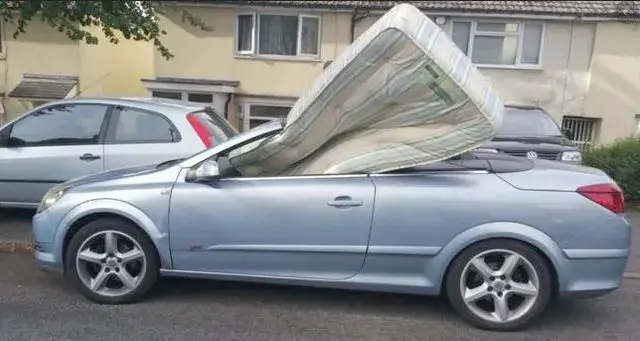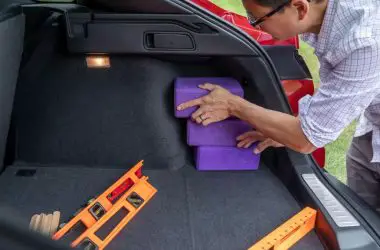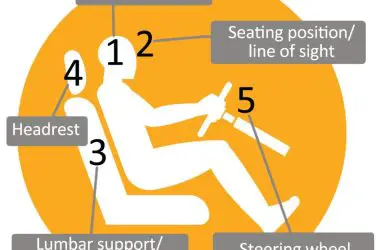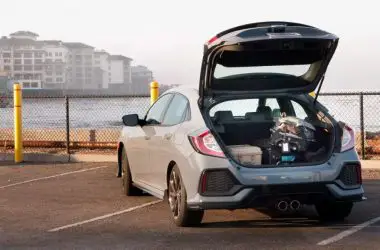Hatchbacks are small cars with a rear door that opens upwards to access the cargo area. Their compact size makes them popular for city driving and parking, but limits their cargo capacity compared to larger vehicles (https://cars.usnews.com/cars-trucks/advice/hatchbacks-with-the-most-cargo-space). While hatchbacks excel at hauling groceries and smaller items, fitting large or oversized objects can be a challenge.
The goal of this article is to provide tips for safely transporting large items like furniture, appliances, and sporting gear in a hatchback. With some clever loading techniques and packing tools, you can haul sizable cargo in your hatchback’s modest cargo hold.
Measure Cargo Area
To determine if large items will fit in your hatchback, you first need to measure the cargo area dimensions. This includes the width, height and depth with the rear seats folded up and folded down.
Use a tape measure to find the width at the widest point between the wheel wells. For height, measure from the floor to the ceiling at the tallest point. Measure depth from the back of the rear seats to the inside of the hatch.
Then fold down the rear seats and repeat those measurements. Folding the seats down will increase depth and possibly height. Make sure to account for any lip or edge at the back when measuring depth.
According to Cars.com, cargo space is measured to the tops of the seatbacks, excluding head restraints. The space above the seats does not count as cargo capacity.
Measure Objects
When transporting large objects in a small hatchback, it’s crucial to accurately measure the dimensions of each item. This will allow you to plan how to load the cargo area efficiently. For large, irregularly shaped objects, measuring may require a bit more care and creativity.
Start by measuring the length, width, and height of the object in inches using a tape measure. If the object is very large or unwieldy, you may need an extra set of hands to hold the tape measure in place while you read the measurements. Round each measurement up to the next inch to give yourself a bit of wiggle room.
If the object is too large to measure in one piece, consider disassembling it into smaller sections before measuring each part individually. This is common for furniture items like beds, dressers, or entertainment centers. Remove detachable legs, doors, shelves, and panels to break the item down into more manageable chunks. Measure and note the dimensions of each piece.
For extremely bulky items that can’t be broken down, like appliances or mattresses, measure along the outside edges and round up generously. If possible, refer to the product specs for exact dimensions. If you don’t have that information available, err on the side of caution.
Once you’ve measured all the pieces, note the dimensions. This will make it easier to arrange everything later. Having accurate measurements is key to fitting oversized cargo in a compact hatchback.
Load Floor-First
When loading large, flat items like mattresses or furniture into a hatchback, it’s best to load them in first, flat on the floor. According to tips from [This Source](https://www.younghouselove.com/hauling-it/), positioning flat items like mattresses and furniture flat on the floor helps maximize the interior cargo space.
Loading large, flat objects on the floor first allows you to stack smaller, more oddly-shaped items on top and around the edges. This utilizes all the available cargo volume efficiently. Trying to fit in a large flat item after loading other cargo often won’t work or results in a very inefficient use of space.
Starting with the largest, flattest items directly on the load floor takes advantage of the length and width of the cargo area. The low center of gravity also helps handling and stability while driving. Just be sure any sharp or pointed objects are well-padded to avoid damaging the flat items underneath. With some clever space planning, you can fit more than you thought in your hatchback.
Use Moving Blankets
One way to protect both your cargo and your vehicle’s interior is to use moving blankets. Moving blankets are thick, padded blankets originally designed to protect furniture and appliances during moves. However, they can also be handy for transporting large items in a hatchback.
Moving blankets act as a soft barrier between your cargo and the interior of your car. The thick padding helps cushion items and prevents them from banging around and scratching your seats or interior panels. The blankets also protect the cargo itself from getting damaged during the drive.
Simply place moving blankets over all interior surfaces that will come in contact with the cargo. Make sure to use enough blankets to provide full coverage. Pay particular attention to protecting the backs of the rear seats, the rear side panels, and the roof. You may need to stack multiple layers of blankets for extra cushioning and protection.
Before loading cargo, ensure the moving blankets are securely tucked around all sides so they don’t shift during transit. Proper use of moving blankets can let you safely carry surprising large and awkward items in your hatchback with minimal risk of interior damage.
According to users on online forums like Reddit, moving blankets are very effective for padding a hatchback when hauling oversized cargo (source). The key is using enough blankets and securing them properly.
Secure the Load
Properly securing the load is crucial to prevent shifting and damage during transport. There are a few key products to use:
- Tie-downs – Nylon or rubber straps with hooks on the ends that attach to loops or hooks in the cargo area. Pull them tight to compress bulky items. Source: How to Easily Tie Down Your Hatch Or Trunk ! – YouTube
- Ratchet straps – Heavy-duty straps with a ratcheting mechanism to tighten them. Great for large, heavy items. Wrap around the load in an X-pattern.
- Moving blankets – Place these over sharp edges or fragile items to prevent rubbing and damage. Can also compress soft items.
- Cargo nets – Stretch these over lighter items like bags to keep them in place.
Attach hooks to the cargo loops or rings in the back and pull the straps tight. Compress items together to prevent shifting. Check straps during longer drives to maintain tension.
Watch Weight Limits
When loading cargo into your hatchback, it is important to be mindful of the vehicle’s weight limits. Exceeding the total weight capacity can put excess strain on the suspension, affect vehicle handling, and reduce braking performance.
According to this Reddit discussion, the difference between a vehicle’s gross weight rating and curb weight is the maximum cargo capacity. This includes both cargo and passengers.
The Plymouth Rock Insurance website notes that a carload of five adults would have to average 170 pounds per person to stay within an 850-pound cargo weight limit. This does not account for luggage.
When loading, be cautious not to exceed the vehicle’s weight limits. Also pay attention to weight distribution and balance. Heavier items should be placed low and centered between the axles. Improperly balanced weight can affect handling and lead to accidents.
Adjust Driving
When driving with a heavy load, it’s important to make adjustments to your normal driving habits to ensure safety. Here are some tips for safe driving with a large load:
- Accelerate slowly and gently. The extra weight will make the car slower to accelerate, so apply the gas pedal smoothly.
- Increase following distance. Leave extra room to stop, at least 4 seconds between you and the car in front.
- Avoid sudden braking. Apply the brakes early and gradually to give the load time to settle.
- Take turns wider and slower. The shifted center of gravity can make handling unstable in turns.
- Watch your speed. Drive below the speed limit and reduce speed further on bumpy roads.
- Downshift for hills and pass with care. Use lower gears on inclines and make sure you have plenty of room when passing other vehicles.
- Allow extra room for backing up and parking.
Adjusting your driving style will help compensate for the changed vehicle dynamics. Focus on smooth acceleration and braking, wide turns, reduced speeds, and increased stopping distance. This will help you maintain control and avoid hazards when hauling oversized cargo in a hatchback.
Use a Trailer
If the items you need to transport are especially large or heavy, using a utility trailer may be a better option than trying to fit them in your hatchback (Source). Trailers provide much more cargo space and often have higher weight capacities than most hatchbacks. For example, a small 5×8 utility trailer can hold over 1,000 lbs and will provide 40 cubic feet of space, whereas most hatchbacks max out around 2,000 lbs capacity and less than 25 cubic feet of space.
When using a trailer, be sure to verify that your hatchback’s tow rating meets the loaded weight of the trailer. Lower powered hatchbacks may only be rated up to 1,500 lbs towing capacity, while more powerful turbo models can typically handle 2,000-3,500 lbs (Source). Driving slower and allowing extra distance for braking is crucial when towing. Weight distribution hitches and sway control can also improve stability. Carefully secure your cargo in the trailer and use appropriate tie downs. Lastly, verify all trailer lights are functioning before each trip.
Summary
When transporting oversized cargo in a hatchback, the most important considerations are taking accurate measurements, loading efficiently to maximize space, securing items properly, and driving cautiously. By carefully measuring both the cargo area dimensions and the objects you need to transport, you can plan the optimal configuration. Loading floor-first and using blankets and tie-downs to stabilize the items are key. Staying within your vehicle’s weight limits and adjusting your speed and turns will also keep you safe. While hatchbacks can haul more than you might think if loaded cleverly, sometimes renting or borrowing a trailer is the best option for large, heavy, or awkwardly-shaped items.
The goal is to transport large objects securely and reach your destination without issue. With some clever packing skills and extra care taken when driving, you can successfully use your hatchback to move items that at first seem bigger than your vehicle can handle.





